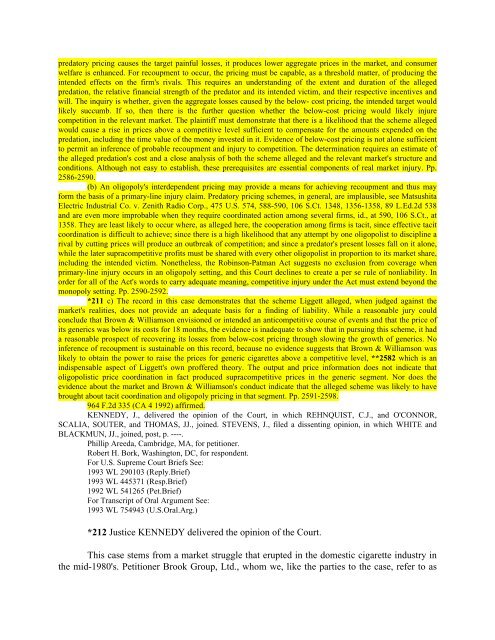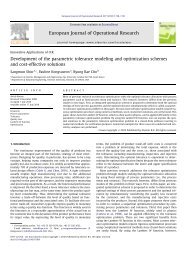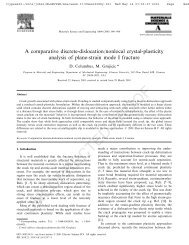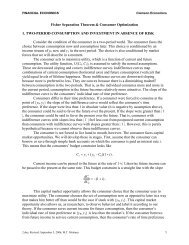509 U.S. 209, 113 S.Ct. 2578 BROOKE GROUP LTD., Petitioner v ...
509 U.S. 209, 113 S.Ct. 2578 BROOKE GROUP LTD., Petitioner v ...
509 U.S. 209, 113 S.Ct. 2578 BROOKE GROUP LTD., Petitioner v ...
You also want an ePaper? Increase the reach of your titles
YUMPU automatically turns print PDFs into web optimized ePapers that Google loves.
predatory pricing causes the target painful losses, it produces lower aggregate prices in the market, and consumer<br />
welfare is enhanced. For recoupment to occur, the pricing must be capable, as a threshold matter, of producing the<br />
intended effects on the firm's rivals. This requires an understanding of the extent and duration of the alleged<br />
predation, the relative financial strength of the predator and its intended victim, and their respective incentives and<br />
will. The inquiry is whether, given the aggregate losses caused by the below- cost pricing, the intended target would<br />
likely succumb. If so, then there is the further question whether the below-cost pricing would likely injure<br />
competition in the relevant market. The plaintiff must demonstrate that there is a likelihood that the scheme alleged<br />
would cause a rise in prices above a competitive level sufficient to compensate for the amounts expended on the<br />
predation, including the time value of the money invested in it. Evidence of below-cost pricing is not alone sufficient<br />
to permit an inference of probable recoupment and injury to competition. The determination requires an estimate of<br />
the alleged predation's cost and a close analysis of both the scheme alleged and the relevant market's structure and<br />
conditions. Although not easy to establish, these prerequisites are essential components of real market injury. Pp.<br />
2586-2590.<br />
(b) An oligopoly's interdependent pricing may provide a means for achieving recoupment and thus may<br />
form the basis of a primary-line injury claim. Predatory pricing schemes, in general, are implausible, see Matsushita<br />
Electric Industrial Co. v. Zenith Radio Corp., 475 U.S. 574, 588-590, 106 S.<strong>Ct</strong>. 1348, 1356-1358, 89 L.Ed.2d 538<br />
and are even more improbable when they require coordinated action among several firms, id., at 590, 106 S.<strong>Ct</strong>., at<br />
1358. They are least likely to occur where, as alleged here, the cooperation among firms is tacit, since effective tacit<br />
coordination is difficult to achieve; since there is a high likelihood that any attempt by one oligopolist to discipline a<br />
rival by cutting prices will produce an outbreak of competition; and since a predator's present losses fall on it alone,<br />
while the later supracompetitive profits must be shared with every other oligopolist in proportion to its market share,<br />
including the intended victim. Nonetheless, the Robinson-Patman Act suggests no exclusion from coverage when<br />
primary-line injury occurs in an oligopoly setting, and this Court declines to create a per se rule of nonliability. In<br />
order for all of the Act's words to carry adequate meaning, competitive injury under the Act must extend beyond the<br />
monopoly setting. Pp. 2590-2592.<br />
*211 c) The record in this case demonstrates that the scheme Liggett alleged, when judged against the<br />
market's realities, does not provide an adequate basis for a finding of liability. While a reasonable jury could<br />
conclude that Brown & Williamson envisioned or intended an anticompetitive course of events and that the price of<br />
its generics was below its costs for 18 months, the evidence is inadequate to show that in pursuing this scheme, it had<br />
a reasonable prospect of recovering its losses from below-cost pricing through slowing the growth of generics. No<br />
inference of recoupment is sustainable on this record, because no evidence suggests that Brown & Williamson was<br />
likely to obtain the power to raise the prices for generic cigarettes above a competitive level, **2582 which is an<br />
indispensable aspect of Liggett's own proffered theory. The output and price information does not indicate that<br />
oligopolistic price coordination in fact produced supracompetitive prices in the generic segment. Nor does the<br />
evidence about the market and Brown & Williamson's conduct indicate that the alleged scheme was likely to have<br />
brought about tacit coordination and oligopoly pricing in that segment. Pp. 2591-2598.<br />
964 F.2d 335 (CA 4 1992) affirmed.<br />
KENNEDY, J., delivered the opinion of the Court, in which REHNQUIST, C.J., and O'CONNOR,<br />
SCALIA, SOUTER, and THOMAS, JJ., joined. STEVENS, J., filed a dissenting opinion, in which WHITE and<br />
BLACKMUN, JJ., joined, post, p. ----.<br />
Phillip Areeda, Cambridge, MA, for petitioner.<br />
Robert H. Bork, Washington, DC, for respondent.<br />
For U.S. Supreme Court Briefs See:<br />
1993 WL 290103 (Reply.Brief)<br />
1993 WL 445371 (Resp.Brief)<br />
1992 WL 541265 (Pet.Brief)<br />
For Transcript of Oral Argument See:<br />
1993 WL 754943 (U.S.Oral.Arg.)<br />
*212 Justice KENNEDY delivered the opinion of the Court.<br />
This case stems from a market struggle that erupted in the domestic cigarette industry in<br />
the mid-1980's. <strong>Petitioner</strong> Brook Group, Ltd., whom we, like the parties to the case, refer to as
















